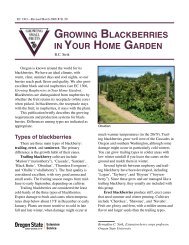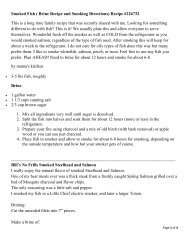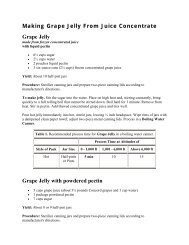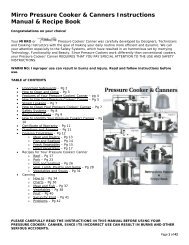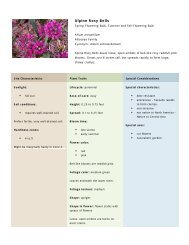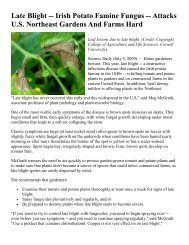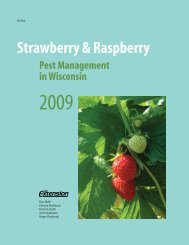Create successful ePaper yourself
Turn your PDF publications into a flip-book with our unique Google optimized e-Paper software.
RHUBARB-Plant divisions in spring, Rhubarb <strong>Planting</strong> Depth<br />
spacing plants. 3 feet apart in fertile soil.<br />
Position crowns 3-4 inches below the soil 3-4"<br />
surface (see illustration at right). Water<br />
heavily, cultivate regularly and feed<br />
generously the first year. Stalks can be lightly<br />
harvested the second year. After that, they may<br />
be pulled over a 6-week period from early spring<br />
until early summer. Plants can be mowed, dug<br />
and divided in either fall or spring.<br />
STRAWBERRIES-Strawberries need well-worked soil with good drainage and plenty<br />
of organic matter. Add 1 pound of fertilizer per 100 square feet. Plant so that the crown is<br />
even with the surface of the soil and make sure all the roots are covered.<br />
Junebearing strawberries produce a single crop. Everbearers produce one crop during<br />
the regular strawberry season and another smaller one later in fall, plus a few fruits in<br />
between. Day neutrals are the truest everbearers, producing fruit spring, summer and fall.<br />
Set strawberries 15-24 inches apart, water well and mulch with straw. Remove blossoms<br />
from Junebearers the first year. Remove everbearer and day-neutral blossoms until July 1,<br />
then allow the plants to set fruit. This alJows the plants to become established so they'll<br />
set far more berries the second year than they ordinarily would have. Water them well,<br />
keeping the top 2 inches of soil evenly moist all season long. Protect in cold climates<br />
with a winter mulch.<br />
ASPARAGUS-Plant 12-18 inches apart<br />
Trenching in Asparagus<br />
in spring or fall. Prepare a deep trench filled<br />
with compost and rich topsoil. Spread the<br />
crowns over the soil and cover them with<br />
2 inches of soil (see illustration at right).<br />
Gradually fill the trench with soil as the<br />
plants grow. If planting in fall, fill the trench<br />
in completely. Each spring, apply 3-5 pounds<br />
of fertilizer per 100 square feet. Work into<br />
the soil before growth starts. Repeat application<br />
after the harvest is complete. Cut the<br />
tops back and mulch in late fall to help prevent deep freezing and sudden changes in soil<br />
temperature. Limit the first harvest to one or two cuttings by mid June of the second year.<br />
A full crop can be harvested the third year after planting, when the spears are 6-10 inches<br />
tall. Harvest for 6-8 weeks only, or until about the first of July in the North. When harvesting,<br />
snap off or cut spears at ground level to avoid injuring new growth.<br />
GOJI BERRIES-Goji berries, or wolfberries, tolerate almost any type of soil, except<br />
wet, soggy soil. They tend to fruit best in well-drained soil of moderate quality. Space<br />
plants 5-8 feet apart in an area with full sun to partial shade. Heavy pruning in the fall<br />
will help keep the plant looking nice and increase fruit production. Goji berries will typically<br />
begin yielding after their second or third growing season, and fruit will ripen over<br />
an extended period starting in July.<br />
HONEYBERRIES-Plants do best in moderately drained, yet moist soil. Mulch to<br />
retain moisture. Plant in full sun where summers are mild; in partial sun where hot and<br />
dry. Set plants 4-5 feet apart-plant at least two varieties, as cross-pollination is required<br />
to produce fruit. Fertilize and mulch annually; prune to maintain shape.<br />
PAGE 12




